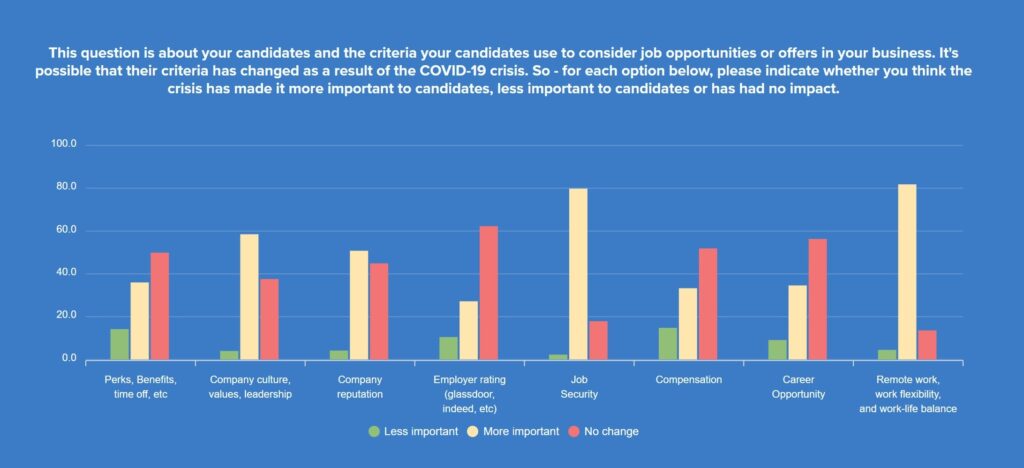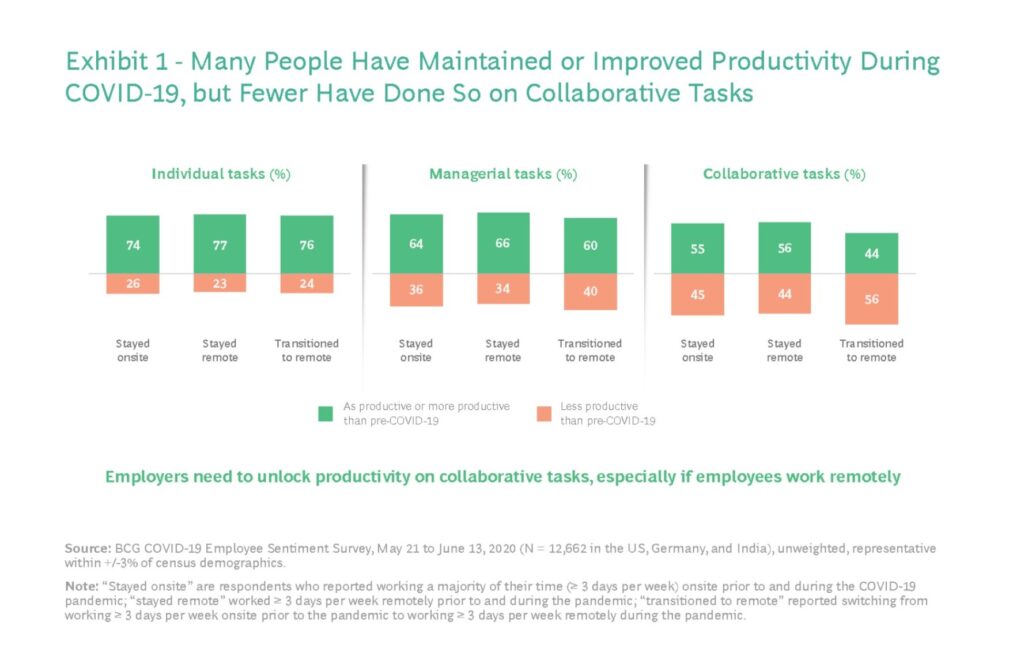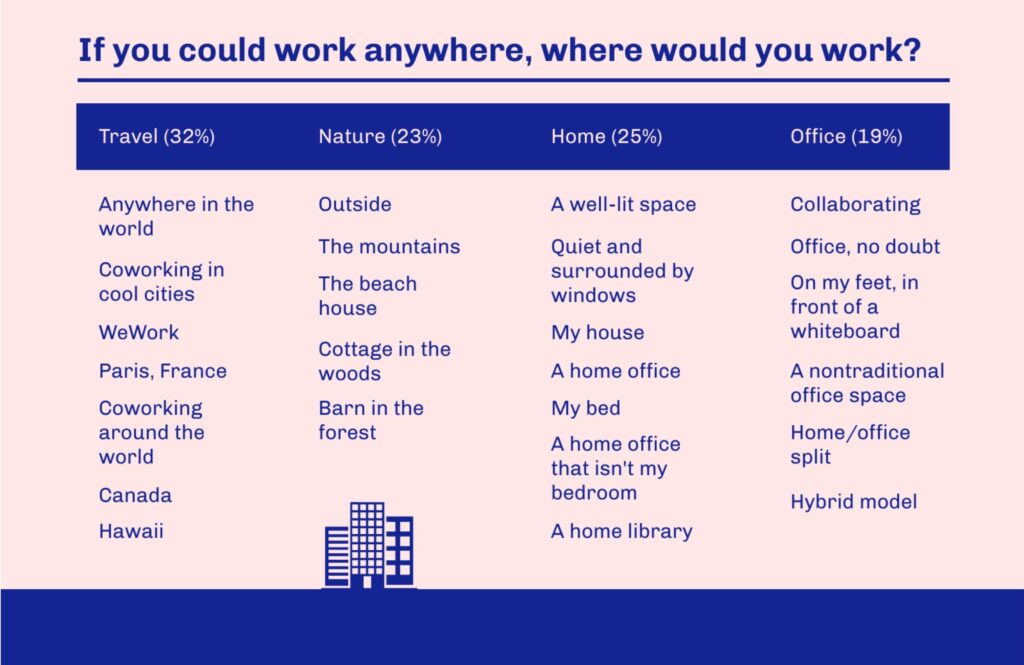Since the industrial age, the typical day of an adult has been trisected into even eight-hour sections: work, sleep, and everything else–life. A growing number of working people, scholars, and researchers have begun to question the working day as a hollow vestige of the industrial era. It is a formidable structure which has come to be defined with commutes, office space, coffee, business travel, and other stalwarts of corporatism. And as of 2020, the lifestyle around work is undergoing its most radical change.
In 2020, the worldwide COVID-19 pandemic forced the majority of international companies to take part in an unprecedented experiment in remote work. Even when the world returns to more stable ground and the threat of the virus disappears, a majority of knowledge work companies have elected to stay distributed – working beyond an office – making significant change to their working models. Technology, like Zoom, Slack, and Tandem, has filled the communication gap, but today’s remote work is still a blunt solution.
The global knowledge workforce is just now beginning to get a sense of the problems and opportunity associated with changing the status quo. Ensuring that distributed work becomes a beneficial evolution will be entirely depending on the intention with which it’s executed. And with the permanent adoption of distributed teams, the infrastructure around work must adapt to a vastly different status quo.
A short history of remote work
Working from home has for years been treated as a perk. A niche of free-thinking Silicon Valley startups and freelancers experimented with working from home and “telecommuting.” Emulating the innovative startups, bigger corporations began experimenting with extremely limited remote work capability, and by the beginning of 2020, the vast majority of knowledge work respondents to a Workable survey said that less than 25% of their workforce was paid to work remotely (Workable 2020). A few months later, in reaction to government-mandated shutdowns, the vast majority of those respondents said that they were fully remote. Only 21.9% of companies said that they weren’t dramatically increasing remote work after the pandemic.

Knowledge work companies of all sizes in Columbus validate the overall embrace of long-term remote work. Rachel Roman, the head of HR at a fast-growing startup in the health insurance industry that employs about 130 people, has emphasized internal initiatives to bolster a seemingly inevitable future of remote work. Challenges have included keeping employees engaged in their work while preserving boundaries – Rachel’s company respects their workers’ privacy and does not run drug tests or credit checks – as many of its workers go remote for the first time.
Other companies, meanwhile, have not needed to change their approach at all. Grace Etter, a senior recruiter for a company in the finance space, noted that the majority of her company, which has headquarters split between California and Ohio, was already working remote. The move, however, affected different roles differently. Developers and engineers, for instance, noticed little change because they tend to work individually and favor a remote environment. Managers and collaborative positions, on the other hand, suffered from the lack of organic interaction.
The results are in
This vast permanent move toward a distributed workforce follows from the surprisingly favorable results of the COVID-19 remote work experiment. The corporate migration from the office is, by any account, a dramatic change driven by nontrivial factors. A BCG survey of more than 12,000 professionals found that around 75% of employees reported subjectively better individual productivity (BCG 2020). Performance, in one large-scale case study of call centers, improved by 13% (Brookings Institute 2020). And as some companies, including Nationwide Insurance, significantly downsize their office spaces, they’re freeing up huge financial assets typically locked into commercial real estate.
The implications of this shift on secondary and tertiary corporate infrastructure, including air travel, downtown restaurants, coffee shops, janitorial services, and commercial real estate, are immense and unprecedented. As the workplace decentralizes, so too must its dependent products and services. Office spaces will need to adjust their value propositioning as their market changes. Perhaps the biggest stakeholder here is the local community employed and surrounded by corporate infrastructure, itself a crossroads of stakeholders, including workers, professional networks, companies, and so on. The shift to remote work has the capacity to help business infrastructure like commercial real estate better serve the local community if done correctly.
On a more personal basis, knowledge workers have noted lifestyle flexibility as a major benefit to remote work. Especially in an asynchronous remote workforce setting, people can spend more time with family, and individuals can pursue hobbies and personal interests with fewer constraints. Opportunities to work outside of a normal setting – work or home – are both exciting to workers and potentially beneficial, leading to better creativity and mental health.

A change of this magnitude, however, is certainly not immune to downfalls. While individual productivity is up, for instance, about half of the 12,000 employees surveyed by BCG noted that collaborative productivity decreased (BCG 2020). This is important – office social interaction, however subtle, can presently only happen in person. “Watercooler conversations,” a term billed by managers, are where employees spontaneously connect about anything – work-related or not – leading to ideation and connection that benefits everyone. BCG, which analyzed its survey findings, noted that well-connected employees were about 2-3 times more productive and collaborative than their less-connected peers (BCG 2020).
Moreover, there is a difference in being productive and feeling productive, one which has been exacerbated with remote work. This leads to longer work days, less satisfaction with work, and intuitively, lower engagement and higher burnout. Combined with the lack of personal interaction, 45% of survey respondents said that loneliness was one of the biggest struggles with working remotely.
Matt Cahoon, the VP of people at a growing software company, notes that remote work requires substantial adjustment by all stakeholders. His company was already 30% remote going into the pandemic, yet the same symptoms – collaboration difficulties, engagement dropoff, and work-life balance – showed up.
What you do and how you live
Perhaps the most important unaddressed area is the lifestyle surrounding work, and the balance between working and “living.” While the notion of flexibility is intuitive, the reality proves much more difficult. During the pandemic, a survey showed that workers were working three more hours per day in a remote setting, an effect stemming from both the lack of interaction and poorly-defined boundaries between work and life (Bloomberg 2020).
This slow bleed of work into life disproportionately affects women, who, during the pandemic lockdown, spent more time on household items and parenting than their male partners, regardless of working arrangements. Working women with young children (0-5) had the most on their plate and the hardest time achieving a sustainable work-life balance (Del Boca et al 2020).
As the problem of work-life blur grows, so grows the opportunity related to rethinking it. The office is no longer a given, and thus neither is the commute, the watercooler, or even the value framework for employees. Increasingly, employees are valued and paid for what they’re able to accomplish, not the hours they’re required to work. “I think what I’m most excited for is the moment when people start admitting to each other they are putting no where near 40 legitimate hours of work in each week,” says Brian Vanden Hogen, a business analyst currently working from home. And as the requirement for 40-hour work weeks loosens in conjunction with fully remote or distributed teams, companies are able to access a larger, more global talent pool.

Employees, perhaps the most important stakeholder, see lots of potential in reframing work as a component to lifestyle and challenging the typical 9-to-5 workday. 80% of survey respondents advocated for a hybrid approach to work, combining office and out-of-office work. If they could choose, in a hypothetical scenario, to work from anywhere, only 19% mentioned an office, and 33% of those noted a hybrid approach. More than half of total responses explored the possibility of combining work and leisure travel, opening the door for “work tourism,” where people could work at coworking spaces from anywhere on an asynchronous schedule. A quarter said they’d like to stay working at home.
There has never been a greater challenge to the stifling constraints of 9-to-5 workdays than the remote work brought on by the COVID-19 pandemic. The way we think about work moving forward will be as a much more consciously integrated lifestyle, not the other way around. To achieve a sustainable and evolved distributed work culture, we must first turn our attention to corporate infrastructure, work-life balance, and the changing meaning behind why we work.
Citations
Boca, Daniela Del and Oggero, Noemi and Profeta, Paola and Rossi, Mariacristina, Women’s Work, Housework and Childcare, Before and During COVID-19 (2020). CESifo Working Paper No. 8403, Available at SSRN: https://ssrn.com/abstract=3644817
Dahik, A., Lovich, D., Kreafle, C., Bailey, A., Kilmann, J., Kennedy, D., . . . Wenstrup, J. (2020, August 11). What 12,000 Employees Have to Say About the Future of Remote Work. Retrieved September 23, 2020, from https://www.bcg.com/en-us/publications/2020/valuable-productivity-gains-covid-19
Guyot, K., & Sawhill, I. (2020, April 06). Telecommuting will likely continue long after the pandemic. Retrieved September 23, 2020, from https://www.brookings.edu/blog/up-front/2020/04/06/telecommuting-will-likely-continue-long-after-the-pandemic/
Mackenzie, K. (2020). Workable Survey: The New World of Work. Retrieved September 23, 2020, from https://get.workable.com/the-new-world-of-work




